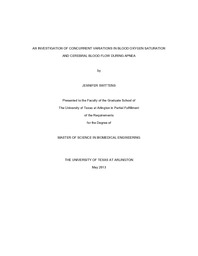
ATTENTION: The works hosted here are being migrated to a new repository that will consolidate resources, improve discoverability, and better show UTA's research impact on the global community. We will update authors as the migration progresses. Please see MavMatrix for more information.
Show simple item record
| dc.contributor.author | Swittens, Jennifer | en_US |
| dc.date.accessioned | 2013-07-22T20:13:40Z | |
| dc.date.available | 2013-07-22T20:13:40Z | |
| dc.date.issued | 2013-07-22 | |
| dc.date.submitted | January 2013 | en_US |
| dc.identifier.other | DISS-12184 | en_US |
| dc.identifier.uri | http://hdl.handle.net/10106/11807 | |
| dc.description.abstract | Sleep apnea derived from Greek word "apnoia" which means "without air or temporary interruption in breathing", is a sleep - associated breathing disorder that involves a decrease or complete stop in airflow despite a constant effort to breathe. It is estimated that sleep apnea is prevalent in the US in 18 million people and is approximately 6% of the population.This thesis aims to study the physiological effects of sleep apnea on cerebral blood flow (CBF) and the percentage oxygen saturation (%SaO2), the effect of duration of apnea episode or a breath hold on CBF and %SaO2 and to derive a relation between CBF and %SaO2. Two studies were performed, simulated apnea study, using breath hold maneuvers to simulate and apnea episode and the sleep apnea study. Simulated apnea was performed on a group of sixteen volunteers (29±5 yr. and BMI 24.1±4.8, 9M and 7F). Sleep apnea was performed on a group of 10 subjects (50.28±9.60 yr. and BMI 31.33±6.29, 8M and 2F). The cerebral blood flow and percentage oxygen saturation were measured for the two groups of patients. The cerebral blood flow was measured using a transcranial doppler system and the percentage oxygen saturation was measured using a digital pulse oximeter. For the simulated apnea study, apnea was simulated using breath hold maneuvers and the %SaO2 and CBF was continuously recorded. The breath hold maneuver was repeated 5 times by each subject. The duration of the breath hold (simulated apnea) was variable, depending on the subject's ability to prolong the breath hold. The time interval between consecutive breath hold was fixed at 30s and 90s intervals to model severe and moderate apnea, respectively. Further, the subjects were tested in sitting and supine position for both severe and moderate simulated apnea; the order of these four protocols was randomized. For the sleep apnea study, 8 hour Polysomnography was performed in a sleep lab.The features extracted from the CBF and %SaO2 waveform were the area under the curve, amplitude of rise, amplitude of drop, time to rise and time to drop. Using these metrics, the physiological variations during both simulated and actual sleep apnea are determined and the results indicate a significant drop in the %SaO2 and significant rise in the CBF waveform. In addition, a significant correlation was obtained for the effect of duration of apnea / breath hold on the CBF and %SaO2. Results also show that there is a significant relation between the %SaO2 and CBF waveforms.A correlation coefficient of 0.69 with a p value of 0.00015 was obtained for the effect of the duration of breath hold on the area of the CBF waveform in simulated apnea study. A correlation coefficient of 0.70 with a p value of 0.00013 was obtained for the effect of the duration of breath hold on the area of the %SaO2 waveform in simulated apnea study. A correlation coefficient of 0.66 with a p value of 0.0008 was obtained for the effect of the duration of apnea on the area of the CBF waveform in sleep apnea study. A correlation coefficient of 0.67 with a p value of 0.0009 was obtained for the effect of the duration of apnea on the area of the %SaO2 waveform in sleep apnea study. This shows that there is a significant relationship between the duration of apnea / breath hold to the area of the CBF and %SaO2 waveforms.A correlation coefficient of 0.56 with a p value of 0.007 was obtained for area of %SaO2 vs. area of %CBF in sleep apnea study. A correlation coefficient of 0.66 with a p value of 0.004 was obtained for area of %SaO2 vs. area of CBF in simulated apnea study. This shows that there is a significant relationship between the cerebral blood flow waveform and the percentage oxygen saturation waveform during a breath hold maneuver. | en_US |
| dc.description.sponsorship | Behbehani, Khosrow | en_US |
| dc.language.iso | en | en_US |
| dc.publisher | Biomedical Engineering | en_US |
| dc.title | An Investigation Of Concurrent Variations In Blood Oxygen Saturation And Cerebral Blood Flow During Apnea | en_US |
| dc.type | M.S. | en_US |
| dc.contributor.committeeChair | Behbehani, Khosrow | en_US |
| dc.degree.department | Biomedical Engineering | en_US |
| dc.degree.discipline | Biomedical Engineering | en_US |
| dc.degree.grantor | University of Texas at Arlington | en_US |
| dc.degree.level | masters | en_US |
| dc.degree.name | M.S. | en_US |
Files in this item
- Name:
- Swittens_uta_2502M_12184.pdf
- Size:
- 2.629Mb
- Format:
- PDF
This item appears in the following Collection(s)
Show simple item record


